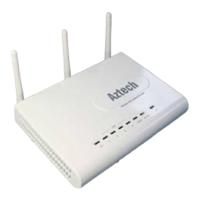User Manual
Detailed Settings
This page provides more technical settings on wireless LAN. These settings should not be
changed unless you know what effect will take.
WMM Support WMM (Wi-Fi Multi-media) function promotes wireless Quality of Service technology. This
function is Wi-Fi WMM compliant.
Enable SuperG Mode Enhance wireless performance when transmitting data.
Fragment Threshold Used for improving the efficiency when there is high traffic within the wireless
network. If you transmit large files in a wireless network, you can enable the Fragmentation Threshold and
specify the packet size. This specifies the maximum size a data packet will be before splitting and creating
a new packet. The setting range is 256-2346. For example: If you set value as 256, it means the packet will
be fragmented into “256” bytes.
RTS Threshold Prevents the “Hidden Node” problem. If the size of the packet transmitted is larger than the
value you set, the RTS will be enabled. When the RTS is activated, the station and its Access Point will use a
(RTS/CTS) mechanism for data transmission. The setting range is 0-2312.
Beacon Interval Indicates the frequency interval of the beacon. A beacon is a packet broadcast by the
Access Point to keep the network synchronized. A beacon includes the wireless LAN service area, the AP
address, the Broadcast destination addresses, a time stamp, Delivery Traffic Indicator Maps, and the Traffic
Indicator Message (TIM).
DTIM Interval Indicates the interval of the Delivery Traffic Indication Message (DTIM). A DTIM field is a
countdown field informing clients of the next window for listening to broadcast and multicast messages.
When the Access Point has buffered broadcast or multicast messages for associated clients, it sends the
next DTIM with a DTIM Interval value. Clients can hear the beacons and awaken to receive the broadcast
and multicast messages
Page 38 of 57

